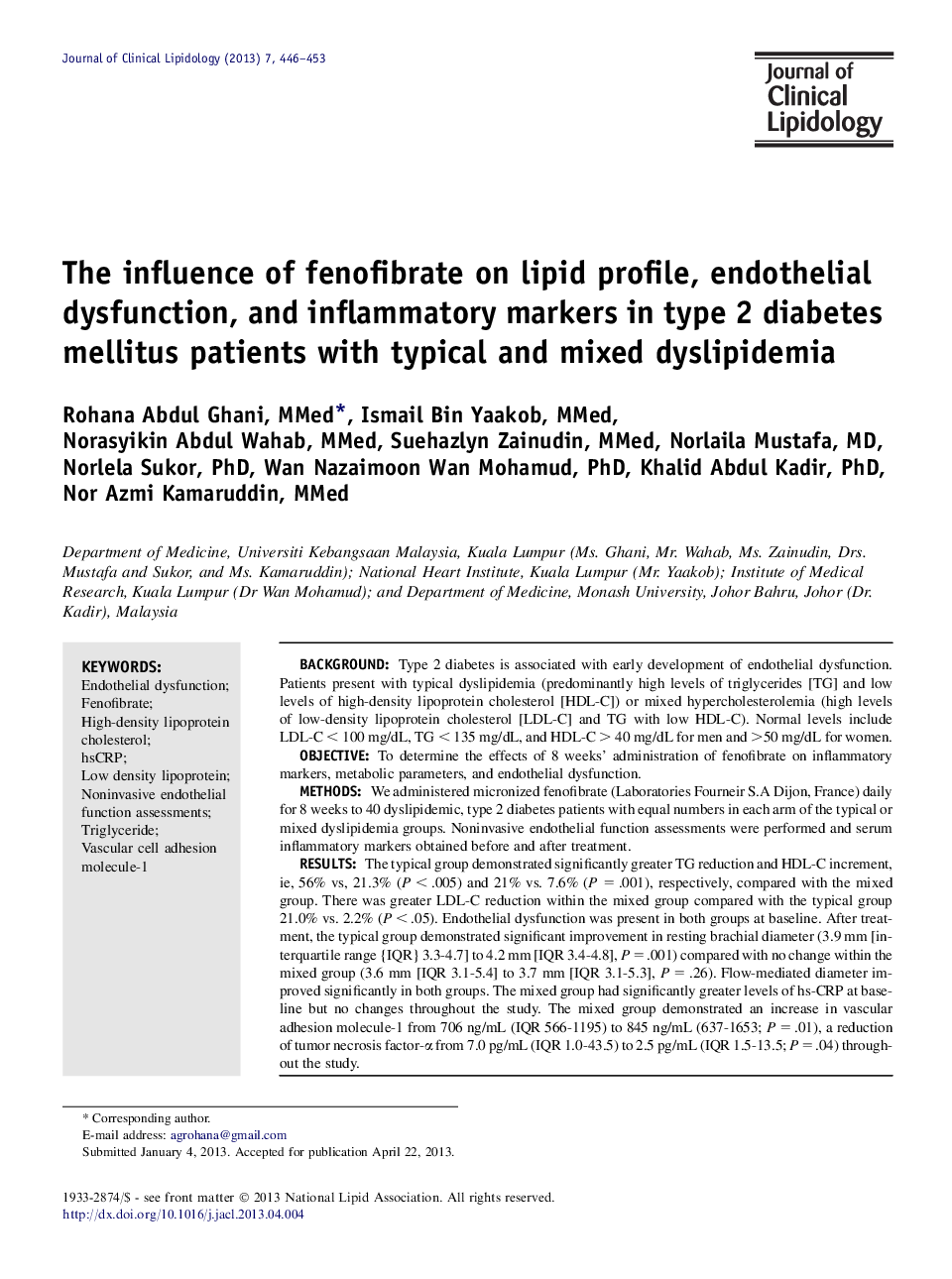| کد مقاله | کد نشریه | سال انتشار | مقاله انگلیسی | نسخه تمام متن |
|---|---|---|---|---|
| 5986086 | 1178799 | 2013 | 8 صفحه PDF | دانلود رایگان |
BackgroundType 2 diabetes is associated with early development of endothelial dysfunction. Patients present with typical dyslipidemia (predominantly high levels of triglycerides [TG] and low levels of high-density lipoprotein cholesterol [HDL-C]) or mixed hypercholesterolemia (high levels of low-density lipoprotein cholesterol [LDL-C] and TG with low HDL-C). Normal levels include LDL-C < 100 mg/dL, TG < 135 mg/dL, and HDL-C > 40 mg/dL for men and >50 mg/dL for women.ObjectiveTo determine the effects of 8 weeks' administration of fenofibrate on inflammatory markers, metabolic parameters, and endothelial dysfunction.MethodsWe administered micronized fenofibrate (Laboratories Fourneir S.A Dijon, France) daily for 8 weeks to 40 dyslipidemic, type 2 diabetes patients with equal numbers in each arm of the typical or mixed dyslipidemia groups. Noninvasive endothelial function assessments were performed and serum inflammatory markers obtained before and after treatment.ResultsThe typical group demonstrated significantly greater TG reduction and HDL-C increment, ie, 56% vs, 21.3% (P < .005) and 21% vs. 7.6% (P = .001), respectively, compared with the mixed group. There was greater LDL-C reduction within the mixed group compared with the typical group 21.0% vs. 2.2% (P < .05). Endothelial dysfunction was present in both groups at baseline. After treatment, the typical group demonstrated significant improvement in resting brachial diameter (3.9 mm [interquartile range {IQR} 3.3-4.7] to 4.2 mm [IQR 3.4-4.8], P = .001) compared with no change within the mixed group (3.6 mm [IQR 3.1-5.4] to 3.7 mm [IQR 3.1-5.3], P = .26). Flow-mediated diameter improved significantly in both groups. The mixed group had significantly greater levels of hs-CRP at baseline but no changes throughout the study. The mixed group demonstrated an increase in vascular adhesion molecule-1 from 706 ng/mL (IQR 566-1195) to 845 ng/mL (637-1653; P = .01), a reduction of tumor necrosis factor-α from 7.0 pg/mL (IQR 1.0-43.5) to 2.5 pg/mL (IQR 1.5-13.5; P = .04) throughout the study.ConclusionsWe effectively compared 8 weeks of fenofibrate therapy in type 2 diabetics with contrasting lipid abnormalities. The typical dyslipidemia group showed significantly greater lipid improvements compared with the mixed dyslipidemia group. Both groups had improvements in endothelial functions that were independent of the lipid levels. We concluded that fibrate therapy in type 2 diabetics is beneficial, especially those with typical dyslipidemia and extends beyond its lipid lowering properties.
Journal: Journal of Clinical Lipidology - Volume 7, Issue 5, SeptemberâOctober 2013, Pages 446-453
